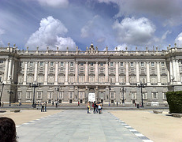
Palácio Real, Madrid
Madrid’s enormous Royal Palace (Palácio Real) was designed by two Italian architects, Filippo Juvarra and G. B. Sacchetti, during the reign of Charles III. The first bricks of this massive undertaking were set down in the year 1735. It took almost another 30 years for construction on this grand palace to be finished. Palácio Real, which is sometimes referred to as Palácio de Oriente as well, was finally ready for the royal court to take up residence in 1764. Before Charles III decided to build on this famous spot, the Moorish Alcázar occupied the land, but that building burned down in an immense fire, which made way for the present-day Royal Palace
You’ll find the luxurious Palácio Real, which boasts almost 300 rooms, within a vast garden and park. Green is everywhere outside, and inside, the stonework of the palace is simply breathtaking, and well worth a visit. Officially, Palácio Real is the main dwelling of the Spanish royalty, but the royals don’t actually live there anymore. The building is for government ceremonies now, and hosting dignitaries, and of course it’s a famous tourist attraction. Thousands upon thousands of visitors flock to Madrid each and every year to walk through it.
As a tourist, you can visit 50 rooms or so. The Plaza Oriente is the main entry point, where you will find plenty of marble statues of Spanish royalty. The palace itself is a treasure trove of wealth, accumulated by the Spanish Empire during the Age of Discovery, and beyond. The Throne Room (Salón del Trono) is rich with elaborate frescos adorning the walls. The Porcelain Room (Sala de Porcelana), in accordance with its name, has an immense collection of beautiful Chinese porcelain. Inside the Gasparini Dressing Room, where Charles III spent a fair amount of time, apparently, you’ll come across some amazingly complicated, and stunningly wrought embroidered silk walls. Take your time as you wander down the halls and the room of the Palácio Real, and see as much as you can see. There’s an awful lot of history contained within these royal corridors.
After you’ve had you fill of the art and pageantry of the palace proper, it’s time to go outside and stroll through the lovely gardens of the Palácio Real. Campo del Moro Park (part of the complex) is rife with water fountains, lawns, cool ponds, and an army of sculpted figures strewn about the grounds. If you happen to stop by for a visit on Wednesday, around 11am, you’ll be treated to the ceremonial changing of the guard. Even if you can’t make this regal event, you should definitely visit the Palácio Real, and learn about Spain’s long and rich history.
 Follow
Follow


